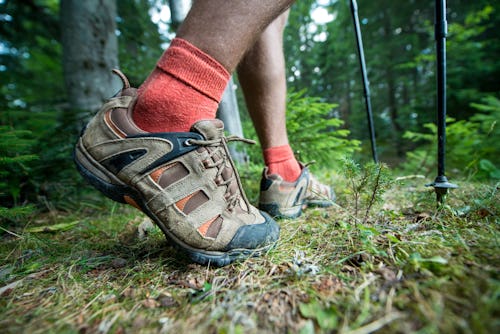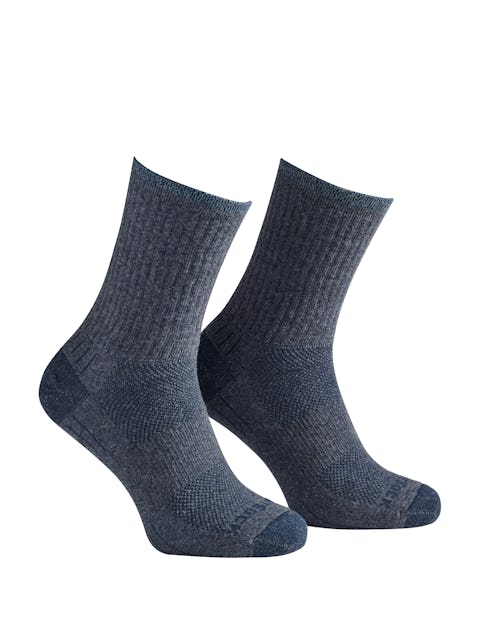
Your feet can make or break your hiking experience. If you’ve got blisters the size of mountains, you’ll likely not be climbing more than molehills.
We invest so much time into choosing the right hiking boots and breaking them in that socks often feel incidental. We’re here to tell you that choosing the right socks is just as important! They’re the essential, supportive underwear for the feet. There is also an abundance of choice, so here’s what you need to know.
After changing my boots one too many times, I wondered if wearing the wrong socks was the real cause of my blisters. I’ve trekked long-distance trails through the Himalayas, South America, and Europe, and suffer from blisters much less frequently these days, thanks to choosing the right socks for my adventure. Let my bruised feet be your guide for better (and comfier) hikes.
Which material should you go for?
Hiking socks are generally made from merino wool, synthetic blends, or bamboo. We cannot stress this enough: avoid cotton. Cotton retains moisture rather than wicking it (drawing it away from the skin), so unless you want wrinkled feet that look like you fell asleep in the bath, cotton is not your friend.
Merino wool is generally considered to be the crème de la crème. It’s incredibly moisture-wicking, so rather than retaining water it draws sweat away from your skin. It’s odor-absorbent too, so if you’re wearing the same socks for days on end (which on a thru-hike is more than likely), fellow hikers will thank you for not perfuming the camp with the aroma of mature cheddar. A higher merino wool content usually equals higher wicking properties.
Bamboo is a relatively new player, also wicks moisture, is odor-absorbing, and is sustainable to boot (bamboo is fast-growing and needs very little water).
Synthetic fabrics (e.g. spandex, polyester and nylon) have chemicals added to them to allow them to wick moisture. Some of these synthetic blends are very effective, but they’re not so environmentally friendly.
What else do I need to know?
Arguably, the most important consideration of all when choosing hiking socks is the fit. Too tight and you’ll reduce the blood supply to your feet. Too loose and they’ll rub and chafe in your boot, causing blisters. Height-wise, mid-calf works best for most boots (you didn’t think you’d be hiking in ballet pump liner socks or retro '00s toe socks, did you?).
Oh, and a little cushioning is nice. Hiking socks without a little padding are like a sofa with no cushions, and given that the average hiker takes 2,000 steps to cover a mile, your feet deserve a little luxury. Invest in socks that cushion your heel and the balls of your feet, these are the places that are going to take the most impact. With the socks that we’ve analyzed below, you’ll be skipping up mountains with all the joie de vivre of a penguin from Happy Feet.
Consider the season that you’re going hiking. You’ll want a thicker sock for winter hikes than for summer coastal strolls. See our guide to gloves for winter hiking.
Input may receive a portion of sales if you purchase a product through a link in this article. We only include products that have been independently selected by Input's editorial team.

Wrightsock’s approach to sustainability is impressive. Their socks use a double layer system, with the inner layer made from recycled plastics (Repreve polyester yarn) and the outer layer from upcycled wool (Recover RWool) which comes from post-industrial scrap. Their blister-free guarantee means that you’ll get your money back or a replacement if you experience blisters. Even with the double layer, these socks feel incredibly lightweight.

With 40% merino wool content, these socks do a great job of thermoregulating and keeping feet fresh with high odor-inhibiting properties. There’s cushioning not only on the sole and heel areas, but the bunion area too (hence the name), so if you’re a trekker who suffers from bunions, these are the very best socks that we can recommend. The materials are sourced and treated sustainably, so Hanwag’s socks are Bluesign.

1000 Mile Sportswear guarantees their socks to do just that: last for 1000 miles. If they wear out in less, the company will replace them for free. The two-layer construction is extremely technical. The inner layer is made from Tactel, an adapted form of nylon that dries 8x faster than cotton and is soft against skin, breathable, and lightweight. The outer layer has a 40% merino wool content. Padded comfort zones on the heel, toe, and Achilles tendon target blister zones.

There’s no ‘one sock fits all’ philosophy with Smartwool, and their sock finder quiz tailors your choice (you can even select the pattern). We’ve included the Mountain Classic Edition for long-distance trekkers, but if you’re a day hiker or going on shorter expeditions you’ll probably want something lighter. At 74% merino wool, they wick moisture very effectively. They include an elasticized arch brace to keep the socks in place, a flat-knit toe seam, and floating levels of cushioning. The above link is for the men's version; women’s version here.

Darn Tough’s socks were built to go the distance and have been used by hikers taking on some of the longest trails in the world. They also donate a proportion of their profits to maintaining popular trails. They’re so confident that their socks will go the distance that they’re guaranteed for life. The 60% merino wool content makes them extremely fast-wicking, they’re made with fine-gauge knitting and fit snug, so there’s no bunches or rubbing. Men’s in the link above; women's socks here.

BAM are market leaders in sustainable activewear, and these socks are made from 68% Viscose Bamboo, with a 17% merino wool content. Bamboo is naturally moisture-wicking and breathable. The elasticated rib on the ankles and instep ensures that these socks stay put in your hiking boots, and they include a half-cushioned footbed. The fabric feels incredibly soft and lightweight.

What did we say about moving away from retro '00s toe socks? We take it back: these low-top socks are great for fastpacking, or people who hike in trail-running shoes. The mesh top panels and arch give extra support on long trail runs, and skin-on-skin friction is eliminated with each toe protected and separated. Marmite they may be, but if you’re a regular blister sufferer, or fast and light is your style of hiking, these socks could be your game-changer.







